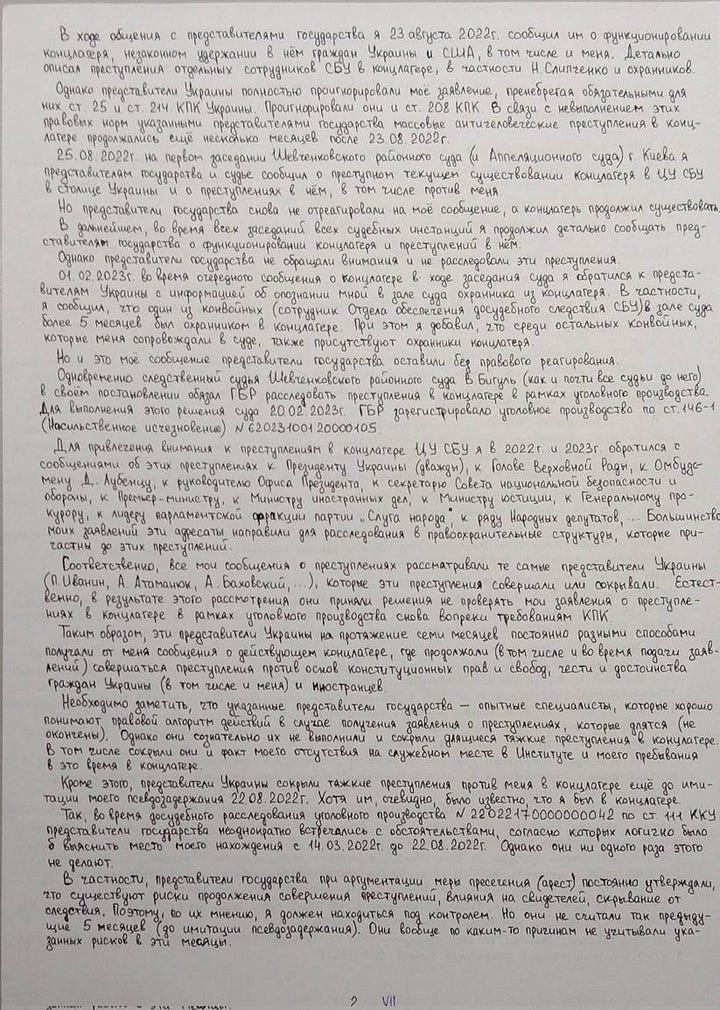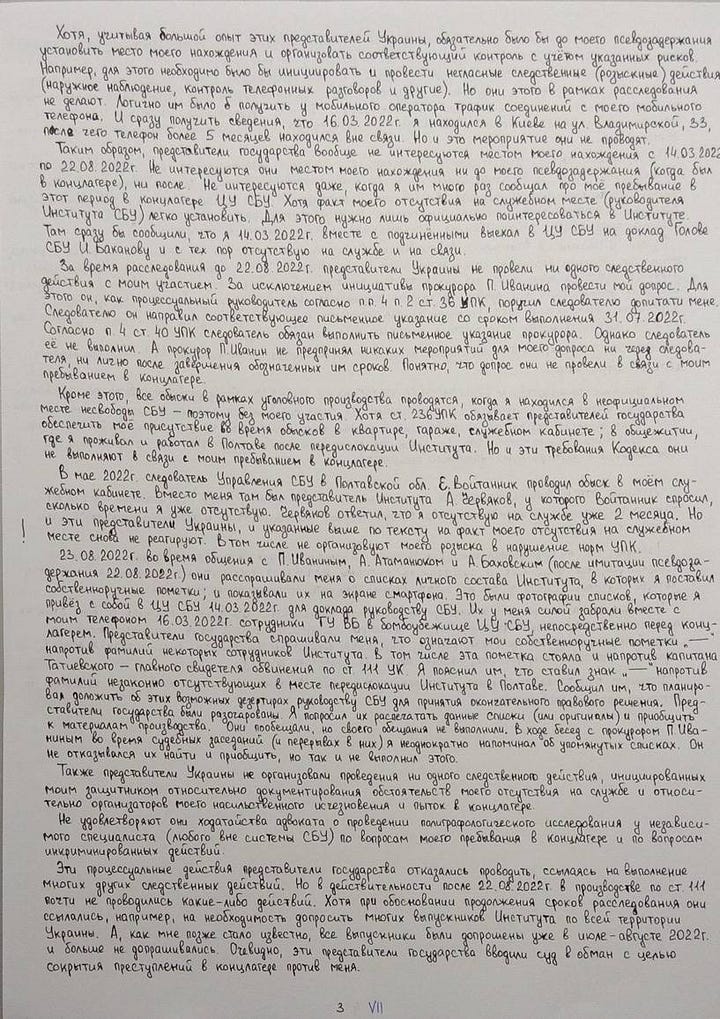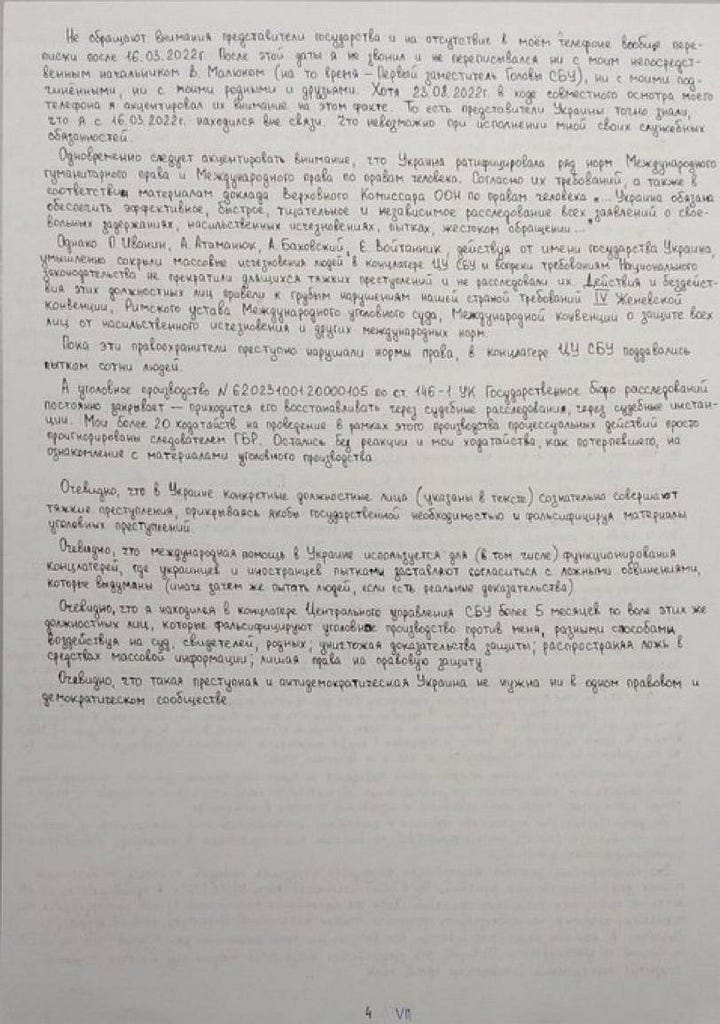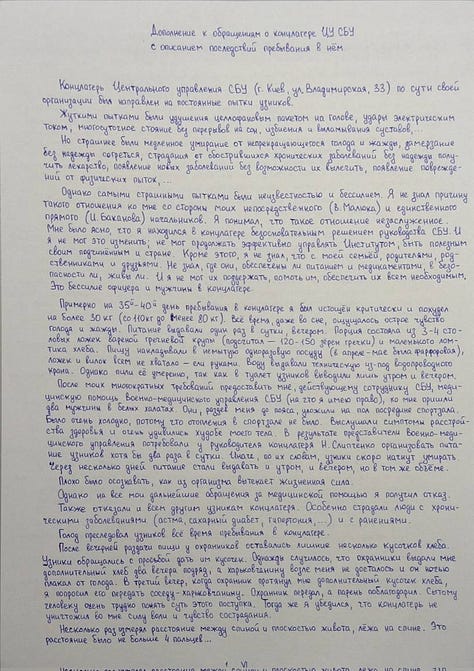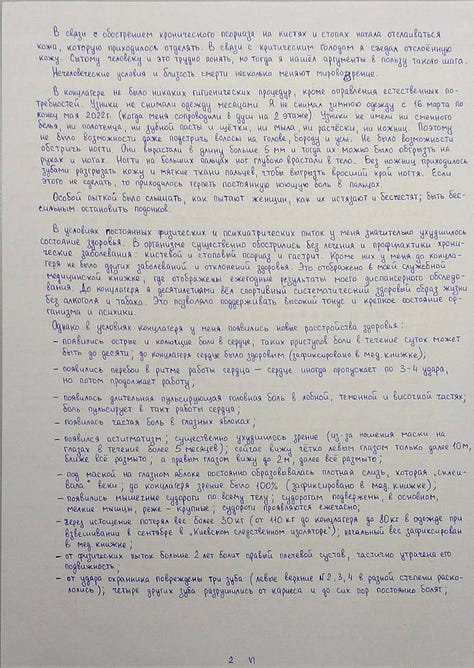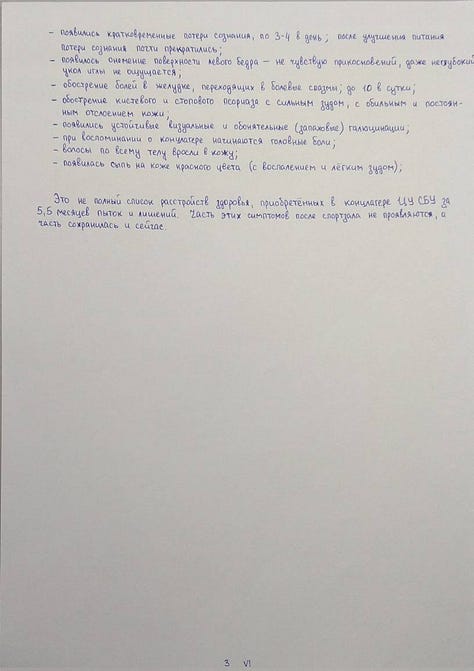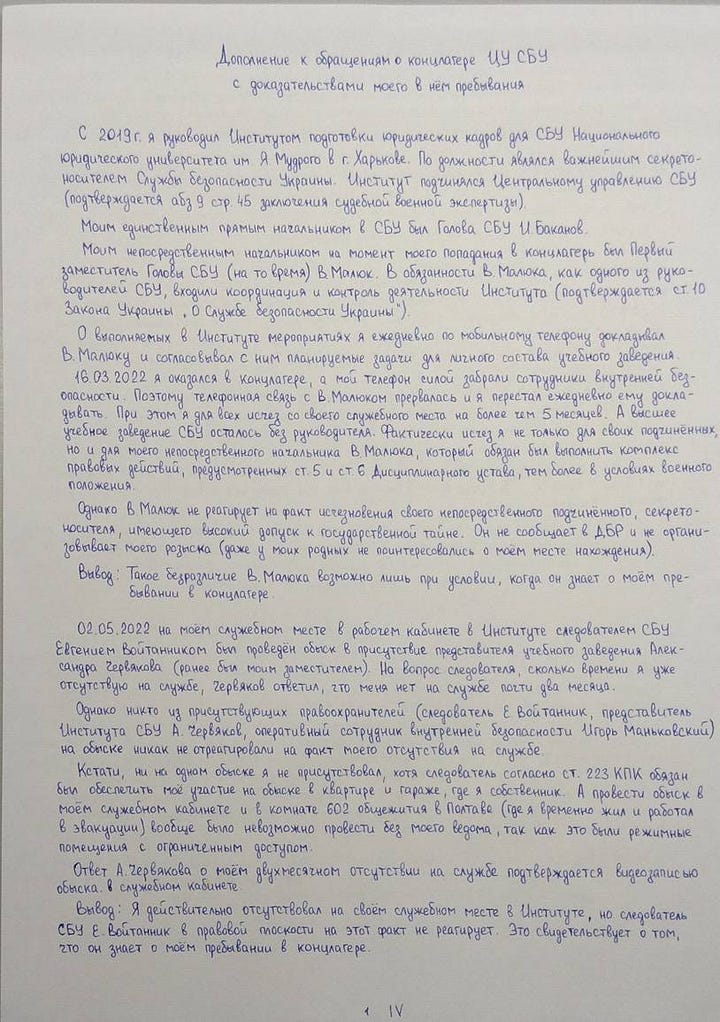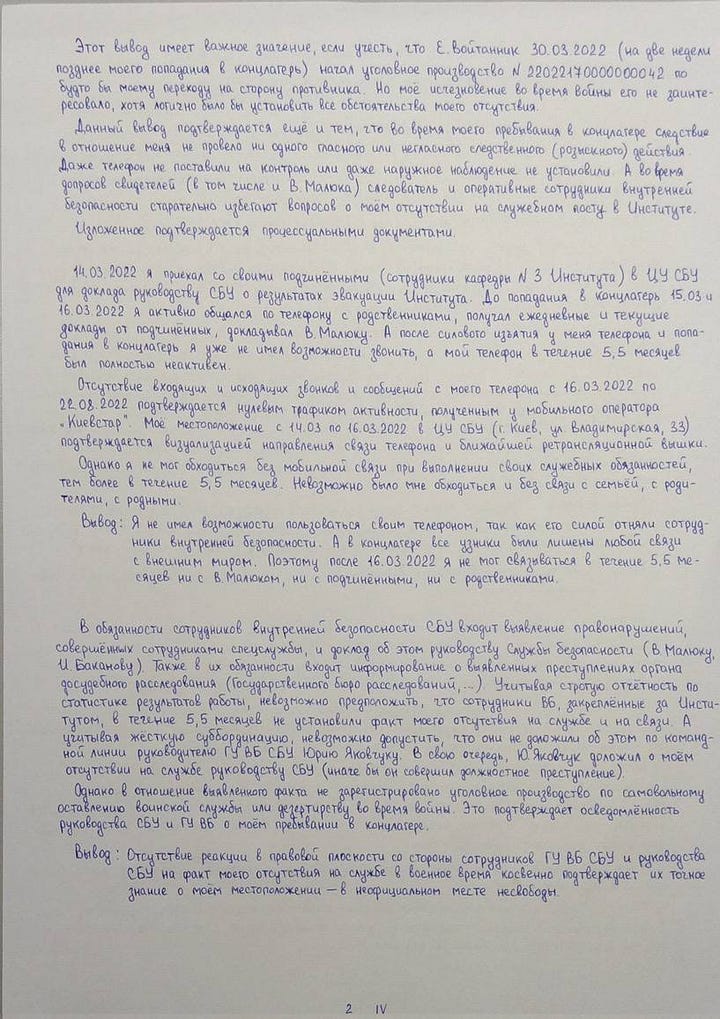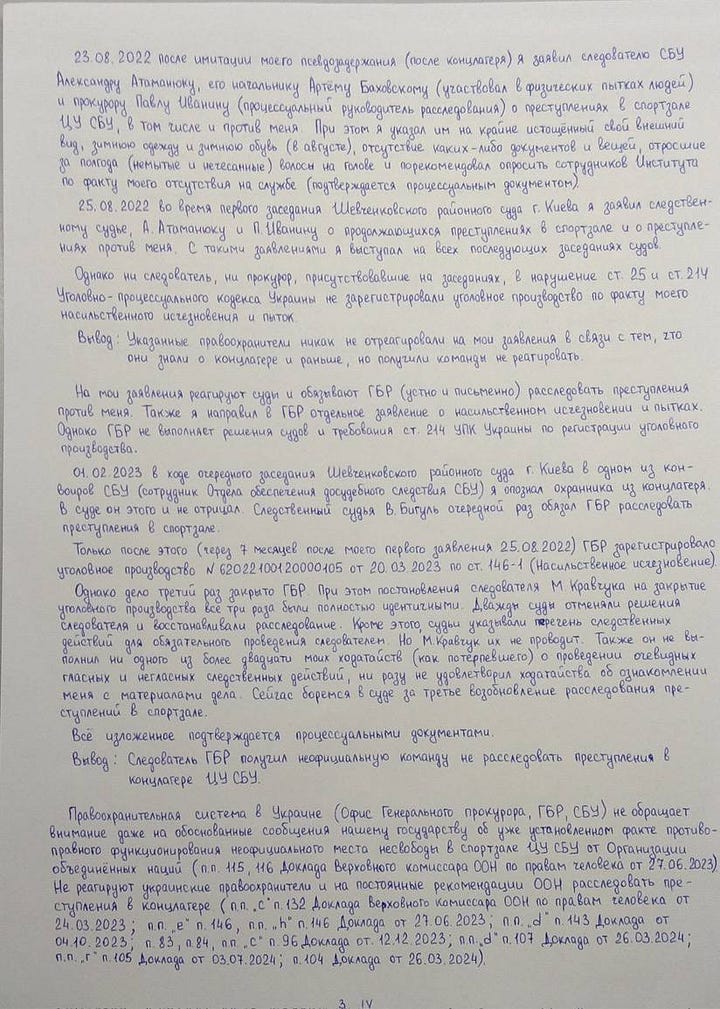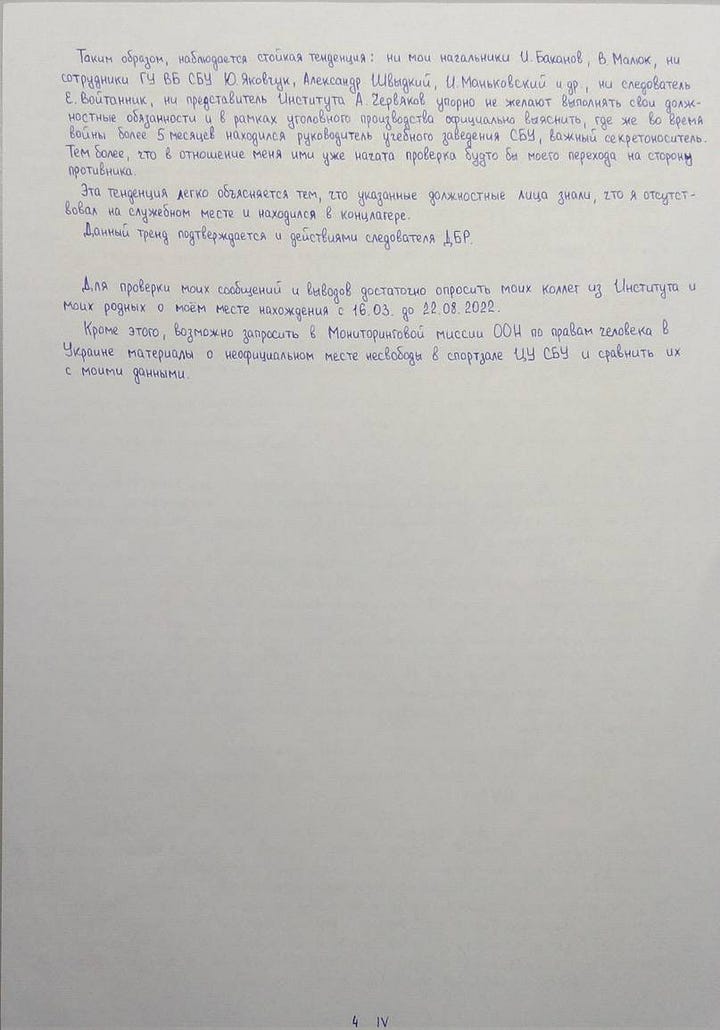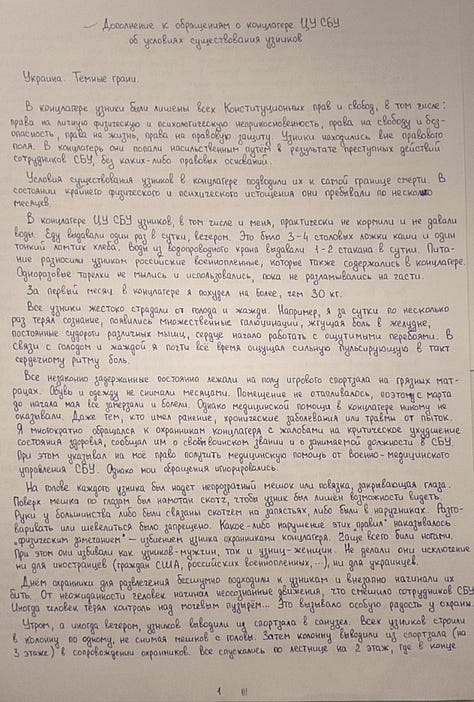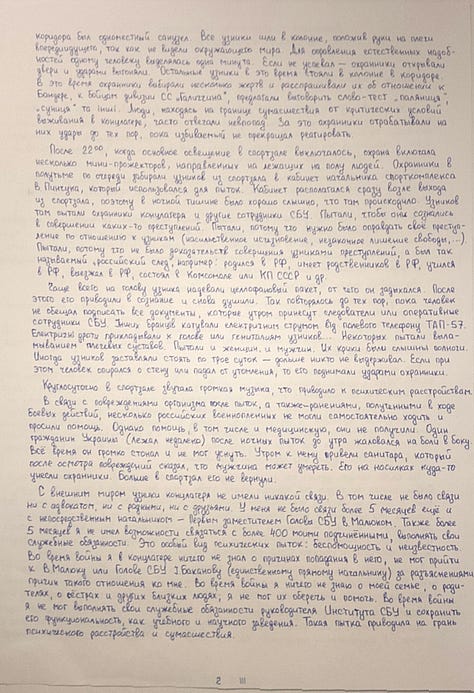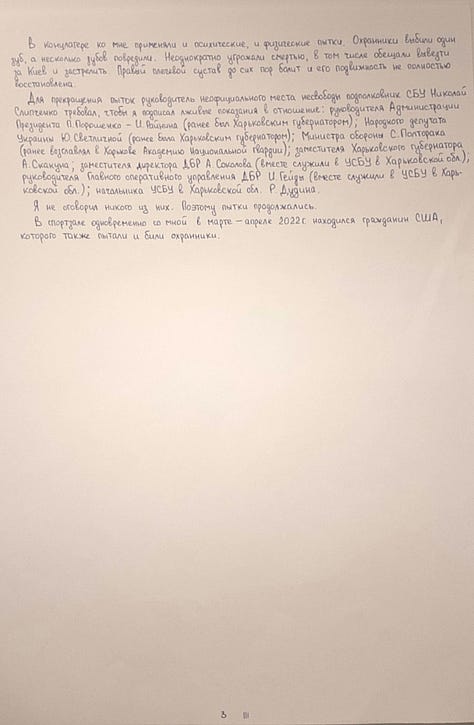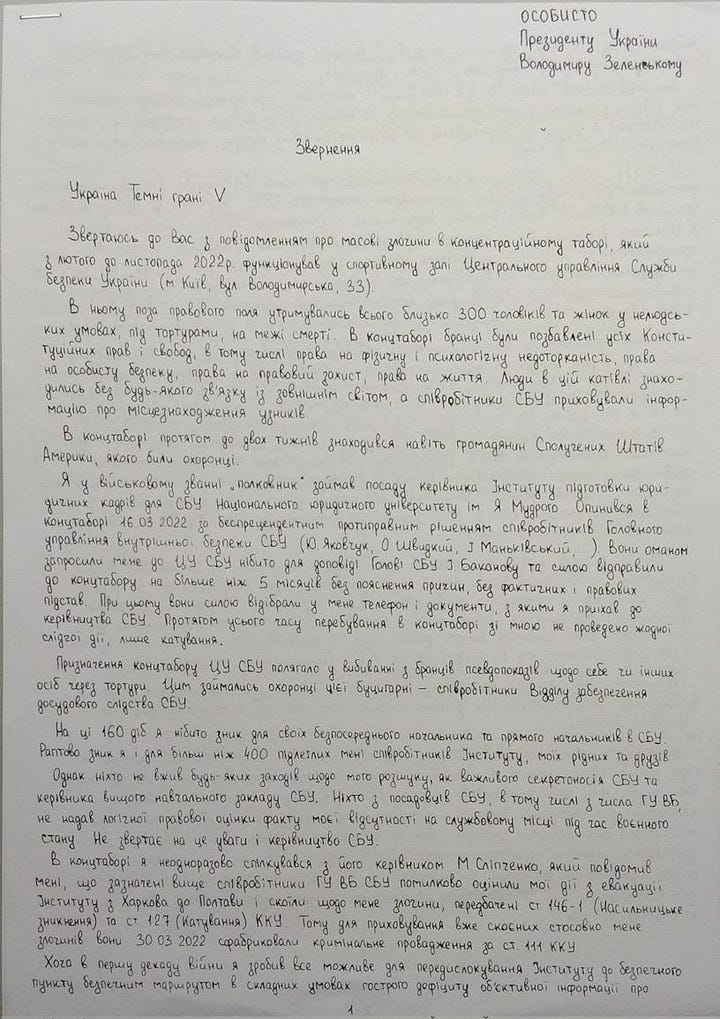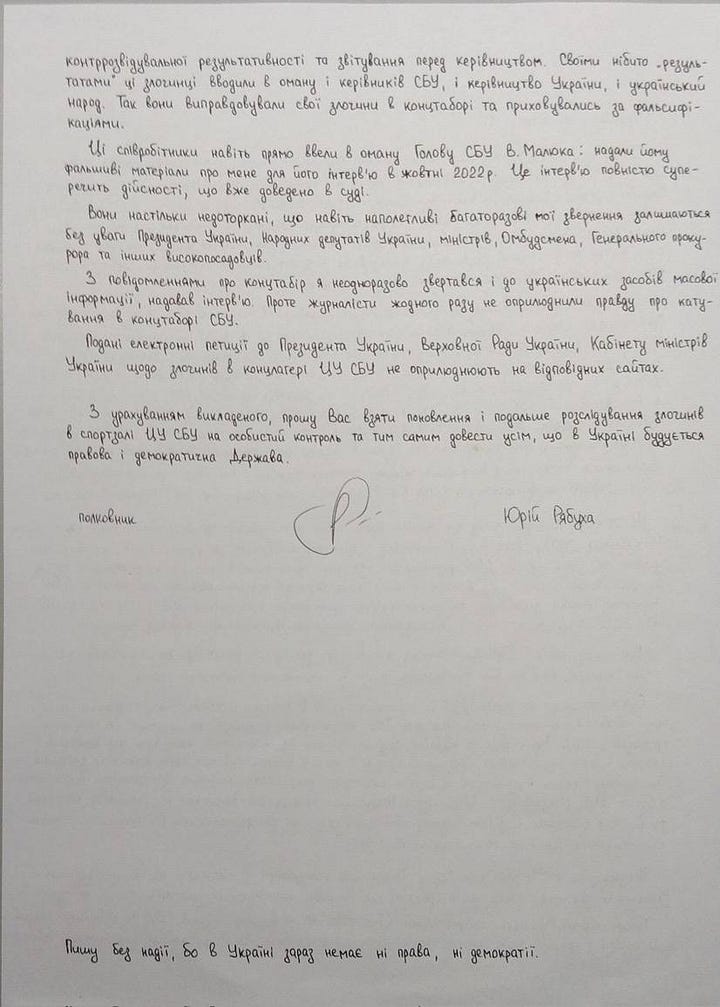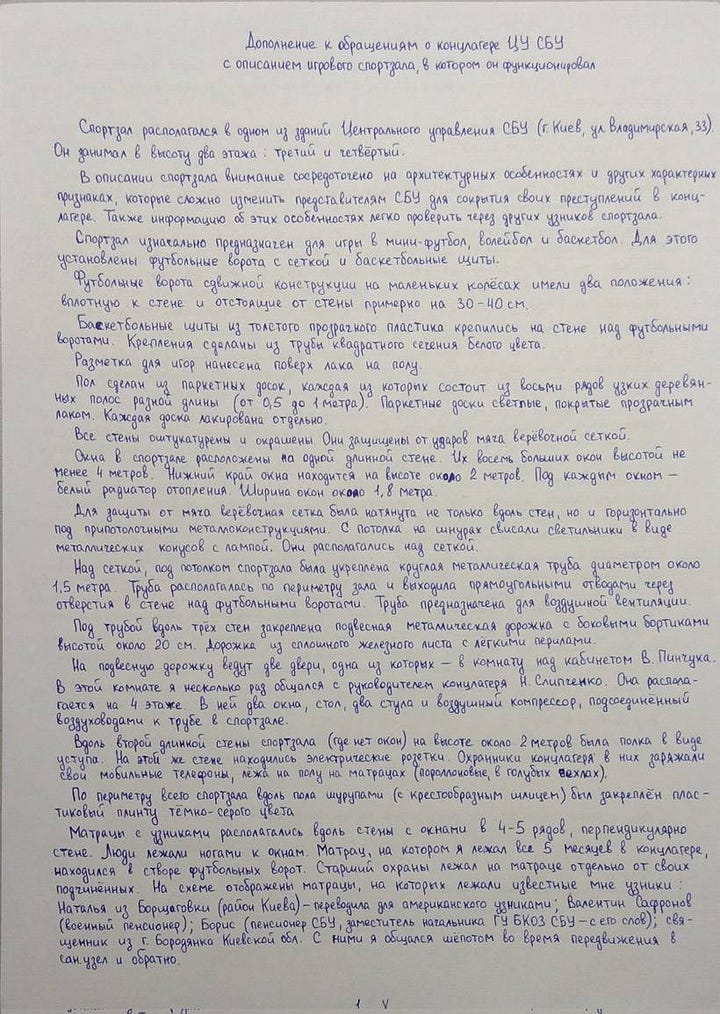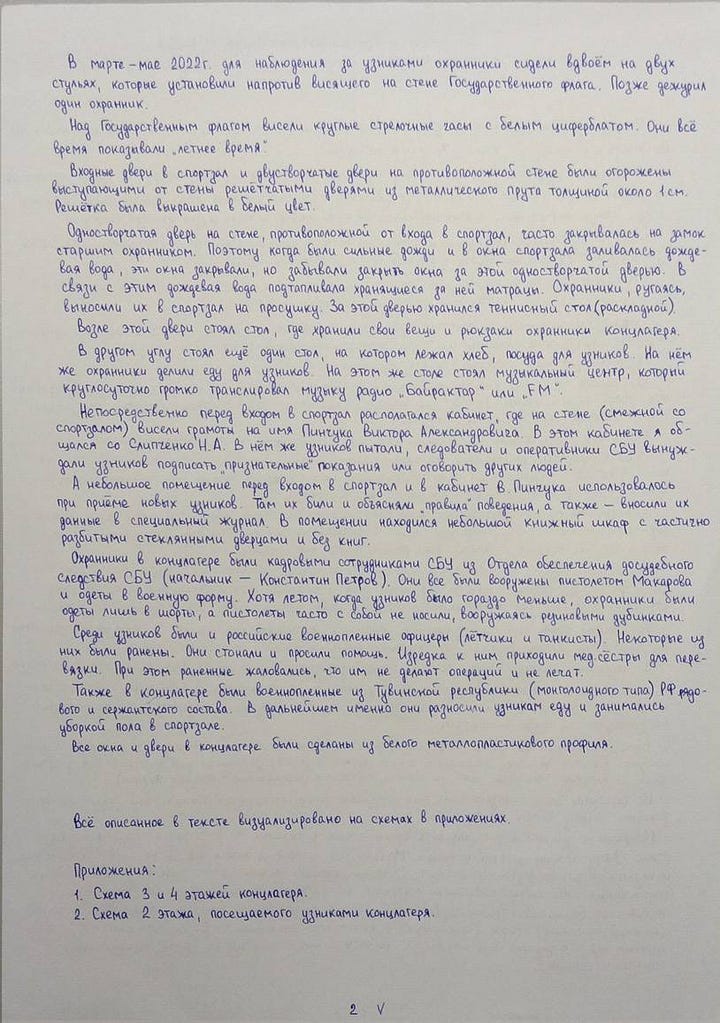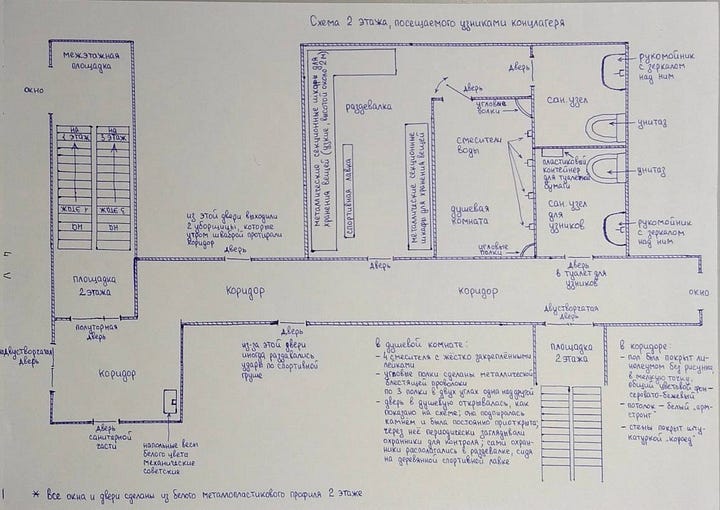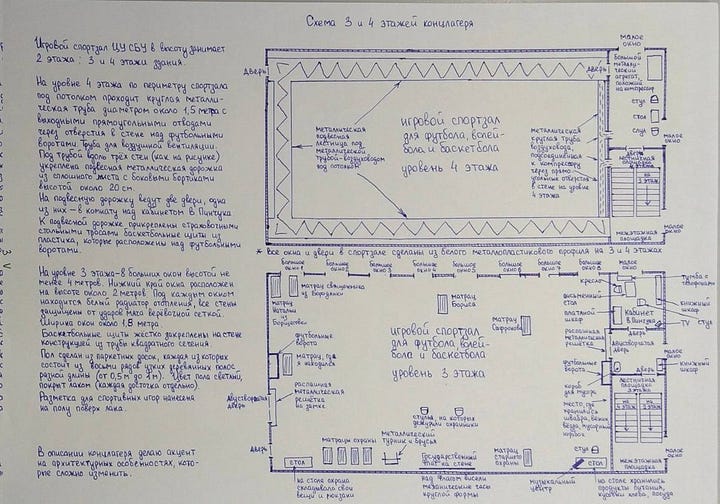“Blueprint for Brutality” – (Ukrainian citizens, Americans and Russian POWs) 🇺🇦 A UNIQUE INSIGHT INTO THE ALLEGED “CONCENTRATION CAMPS” IN UKRAINE! –
A survivor, former inmate and former SBU colonel shared their story!
Article snippet: Ukrainian citizens, Americans (like Gonzalo Lira) and Russian POWs were forcibly blindfolded, sometimes with use of plastic bags. Hands were bound with tape or cuffs, immobilized victims would be each given a thin mattress to lay on.
Auditory torture began immediately. A sound system blasted loud radio (“Bayraktar” or “Kyiv FM”) 24/7 near the prisoners, drowning out screams from adjacent interrogation sessions while inducing mental disintegration. An approach known as “futility” or “learned helplessness”, the purpose of this technique is to persuade the detainee that resistance is futile as per old U.S. Army interrogation manuals.
Starvation protocols followed. One meal per day (3–4 tablespoons of buckwheat, one small slice of bread) was issued initially, causing rapid weight loss. Ryabukha would lose 30+ kg (over 65 lbs.) in 40 days. After SBU medics warned detainees “would soon begin to die,” rations increased to two equally insufficient daily portions. Hunger triggered hallucinations, fainting, organ dysfunction and ultimately led to death in some cases.
Colonel’s Disappearance
Via: Peter Ermolin and Lord Bebo
-> Read and see what you fund with your taxes! -> In March 2022, Colonel Yuri Ryabukha, Head of the Yaroslav Mudry’s National Legal Academy arrived at Ukraine’s Security Service (SBU) Central Office on 33 Volodymyrska Street in Kyiv for a meeting but never walked out. For 160 days, he would vanish into a hidden concentration camp operating right in the middle of SBU’s own soaring two floor Soviet-era gymnasium.
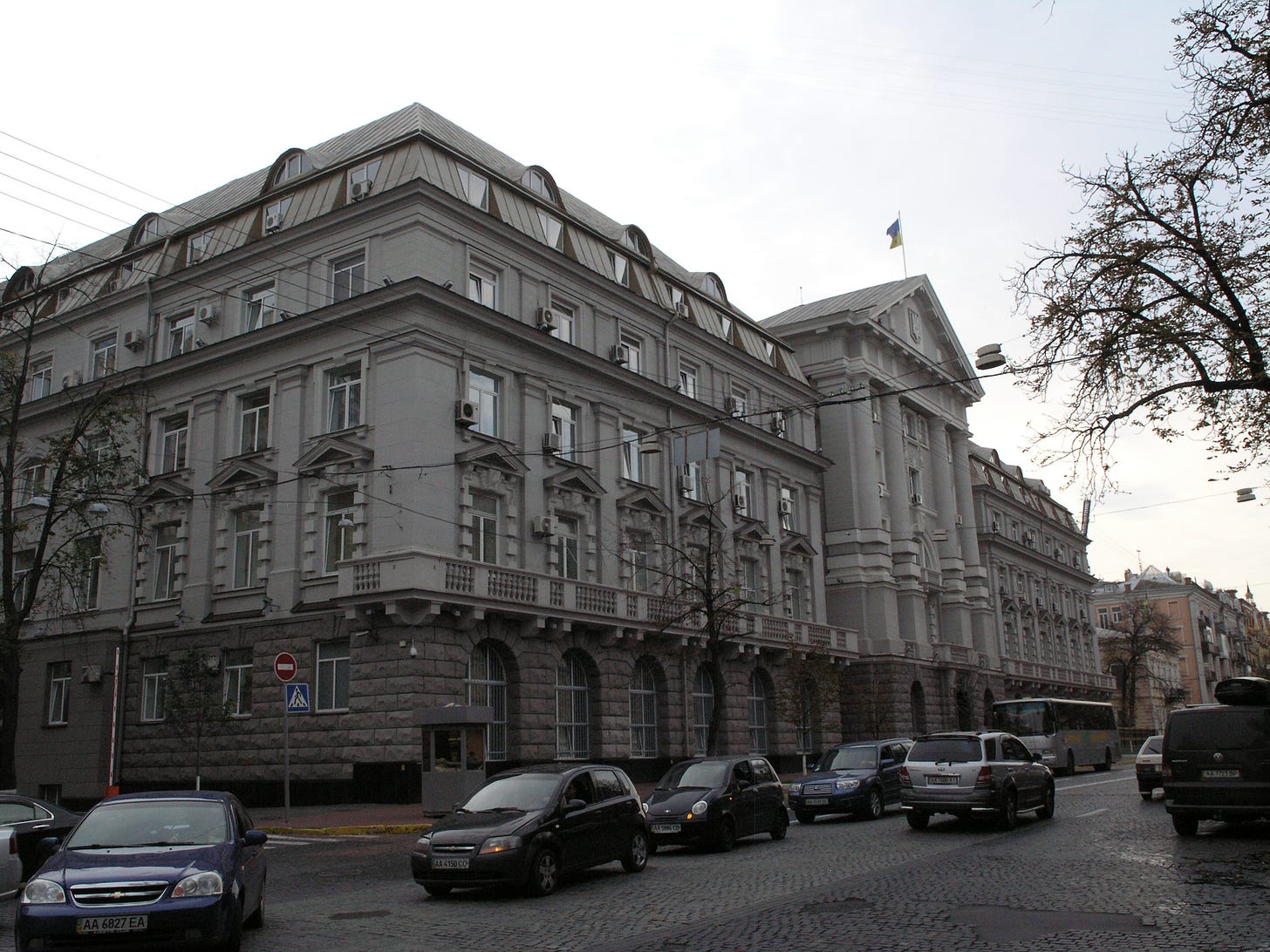
Last Day of Light
On 16th of March 2022, Yuri Ryabukha who travelled to Kyiv, accompanied by his subordinates from the Faculty for Training SBU Preliminary Investigators at Yaroslav Mudry’s National Legal Academy, was ready to deliver a critical report to the Security Service leadership on the recent relocation of his Kharkiv based Institute to Poltava. Just 20 days ago the Russian Federation had launched what it called the ‘Special Military Operation’ against Ukraine. As he stood in the bomb shelter of SBU’s main facility, waiting to diligently deliver the reports on personnel and successful relocation to his superior and Head of SBU at the time – Ivan Bakanov, internal security agents surrounded him and drew their weapons. Having confiscated his firearm, phone and all belongings, they put a hood over his head and tightly secured it around his eyes with duct tape. Blindfolded Ryabukha was then dragged upstairs to the third floor, into the gymnasium.
A veteran Colonel with 30 years of service and numerous awards for safeguarding his country, became a victim of the chaos and lawlessness that engulfed Ukraine. From the outset of Russia’s incursion and to this day, an unrelenting search for the ‘Russian trace’ continues. In a сountry where every second person has ties to neighboring Russia—it is a recipe for disaster. People in fear of persecution and conscription began to flee Ukraine in those early days. Millions would cross the border searching for safety in the EU and Russia. Others weren’t so lucky—abductions, religious purges and outright executions by the so called ‘territorial defense’ volunteers and far right elements would forever change the country’s psyche and demographics.
Colonel Yuri Ryabukha was detained by the SBU internal security officers for relocating his SBU Legal Institute to Poltava. A sound call from a strategic point of view, given Kharkiv’s geographical vulnerability—the city stands only around 30 km (less than 20 miles) from the Russian border. Yet a call deemed as insubordination by his leadership. Ryabukha was viewed as a risk due to having relatives in Russia. He would endure brutal torture, applied with chillingly textbook methodology. In SBU detention—Ryabukha would suffer injuries leaving him permanently disabled and with lifelong psychological trauma.
The decision to imprison without any due process and to torture an honored veteran of the SBU was ultimately made by the Head of Ukraine’s Security Service—Ivan Bakanov. A childhood friend of Volodymyr Zelenskyy, CEO of the “Kvartal 95” studio that produced the comedian’s sketches, and former leader of the “Servant of the People” party (from 2017 to 2019). Bakanov was appointed as the new Head of Ukraine’s Security Service, shortly after Zelenskyy’s election victory, on 29th of August 2019. Perhaps a strange choice, considering he had no experience in public service or law enforcement agencies but it didn’t matter.
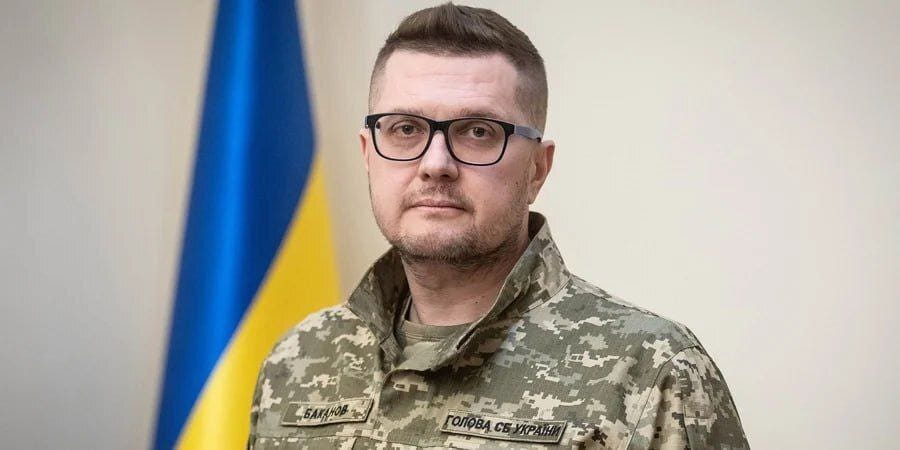
Volodymyr Zelenskyy prior to his election, pledged to make peace with predominantly Russian-speaking regions in Eastern Ukrainian and to clean up Ukraine’s corrupt oligarchy. While the slogans worked, he and his associates had fooled the electorate. The Pandora papers, leaked to the International Consortium of Investigative Journalists revealed that Zelenskyy & Co. hid their multi-million dollar assets offshore. Sadly these revelations would come far too late. Zelenskyy and Bakanov were about to plunge Ukraine into unprecedented darkness and bloody terror. The harrowing story of Colonel Ryabukha and other prisoners in the SBU camp lays bare these depths.
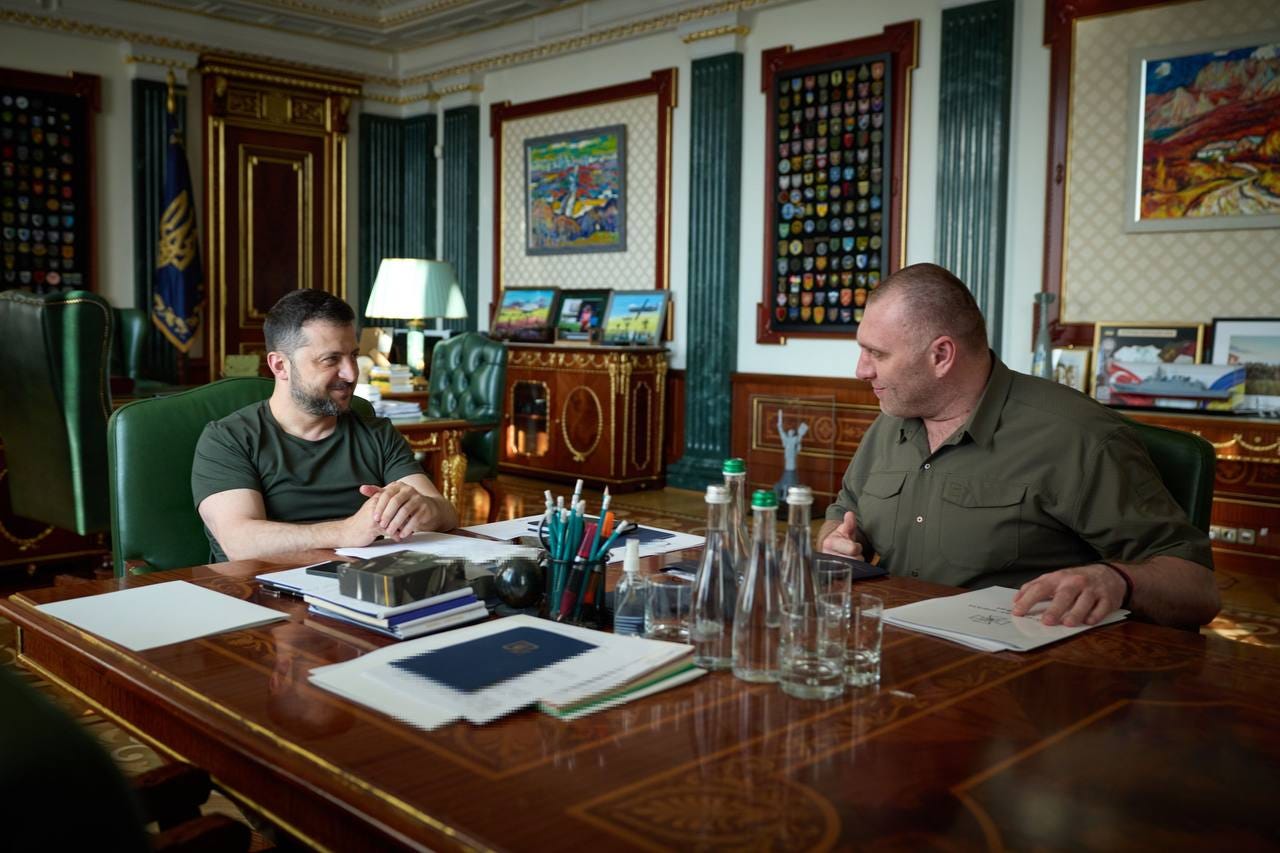
Blueprint for Brutality
According to Ryabukha’s whistleblower testimony, the SBU ‘gym‑camp’ held more than 300 detainees, including Ukrainian and U.S. citizens like Gonzalo Lira. Lieutenant Colonel Nikolay Slipchenko—known as the camp commander—led SBU officers who carried out beatings, starvation, suffocation and electro-shock torture. They coerced false confessions implicating alleged Russian ties or accusations against former high‑ranking Ukrainian officials.
Another key figure at the concentration camp was Viktor Oleksandrovych Pinchuk (not to be confused with Viktor Mykhailovych Pinchuk – Ukrainian oligarch). Colonel Ryabukha recalls individual torture sessions taking place in his office, adjacent to the gymnasium. The office had certificates hanging on walls bearing his name.
It is important to note, that there are four elements essential to establish torture under the UN Convention Against Torture. These elements are: severe pain or suffering (physical or mental), intentional infliction, specific purpose (gaining information, intimidation or coercion), and involvement of a public official acting in an official capacity.
Colonel Ryabukha’s chilling account of torture methods and of the concentration camp layout give us more insight than ever before into human rights violations committed by Ukrainian authorities. His testimony supports already existing evidence presented in the UN OHCHR reports and articles, such as Oleksandr Dubinsky’s claims on existence of concentration camps.
Oleksandr Dubinsky—Ukrainian MP and whistleblower, who also widely reported on the crimes and torture implicating SBU. Currently he is compiling the so-called: ‘Dubinsky List’, to help bring to light to the stories of victims of SBU concentration camps and to hold perpetrators accountable.
Dubinsky’s and Ryabukha’s accounts of actions committed by the SBU meet the full legal definition of torture under the UNCAT.
Torture Methods
Upon arrival, detainees (Ukrainian citizens, Americans and Russian POWs) were forcibly blindfolded, sometimes with use of plastic bags. Hands were bound with tape or cuffs, immobilized victims would be each given a thin mattress to lay on.
Auditory torture began immediately. A sound system blasted loud radio (“Bayraktar” or “Kyiv FM”) 24/7 near the prisoners, drowning out screams from adjacent interrogation sessions while inducing mental disintegration. An approach known as “futility” or “learned helplessness”, the purpose of this technique is to persuade the detainee that resistance is futile as per old U.S. Army interrogation manuals.
Starvation protocols followed. One meal per day (3–4 tablespoons of buckwheat, one small slice of bread) was issued initially, causing rapid weight loss. Ryabukha would lose 30+ kg (over 65 lbs.) in 40 days. After SBU medics warned detainees “would soon begin to die,” rations increased to two equally insufficient daily portions. Hunger triggered hallucinations, fainting, organ dysfunction and ultimately led to death in some cases.
Nightly escalation involved guards selecting prisoners for interrogation in Viktor Pinchuk’s office. Forced standing was imposed: victims stood for up to 72 hours without rest; those who collapsed were beaten. Simultaneously, electrocution was administered using wires from a TA-57 field telephone attached to genitalia, head or open wounds. A practice pretty commonly applied in post-Soviet countries.
Communication with the outside world was nonexistent. Families had no information and believed their loved ones were dead. Russian POWs, wounded Ukrainians, and U.S. citizens held in the concentration camp all endured identical treatment.
The final coercion phase involved suffocation (plastic bags over the head) and electrocution while threatening execution unless detainees signed false confessions claiming connections to former Ukrainian officials or Russia. Those who resisted like Colonel Ryabukha, were subjected to repeated torture cycles. He never signed anything.
This systematic abuse—documented across 160 days—targeted all prisoners uniformly, exploiting sensory deprivation, physical torment and psychological annihilation to extract confessions.
A story grimly reminiscent of Gonzalo Lira’s death in SBU custody. Like the prisoners starved and beaten at 33 Volodymyrska Street—the American journalist faced medical neglect eventually culminating in fatal pneumonia. Further underscoring Ukraine’s failure to uphold international standards for prisoners during wartime, despite UN documentation and victims’ pleas.
Layout
- The gymnasium spanned the 3rd and 4th floors of the SBU Central Office at 33 Volodymyrska Street in Kyiv.
- Eight tall 4‑meter windows line one wall, with heating radiators beneath them.
- A metal catwalk suspended under the ceiling ran along the walls.
- A ventilation shaft hung above the hall.
- A toilet on the 2nd floor was accessed twice daily—guards led detainees one by one, blindfolded; each given one minute for hygiene.
- Viktor Pinchuk’s office was adjacent to the gymnasium and used for prisoner interrogation.
- The processing room where new arrivals were logged and beaten, had an empty bookcase with glass-doors.

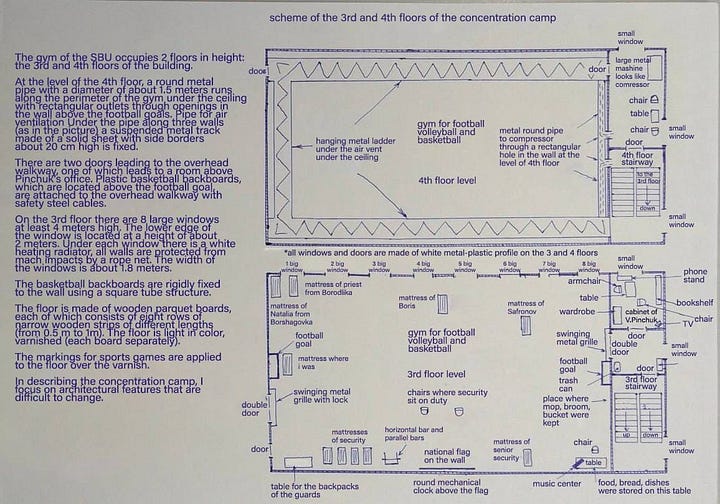
State Cover-Up
From the testimony provided by Colonel Yuri Ryabukha, it becomes clear that the Ukrainian citizens imprisoned in the concentration camp were tortured in order to establish their links to Russia. Even if they had to falsely confess to those links.
More interestingly Ryabukha notes that Nikolay Slipchenko personally demanded that he signs a false confession implicating key figures of the previous administration of Ukraine under Petro Poroshenko:
“To stop the torture, the head of this unofficial place of detention, SBU Lieutenant Colonel Nikolay Slipchenko demanded that I sign false testimony against: former Head of the President’s [Petro Poroshenko] Administration Ihor Rainin (former Kharkiv governor); Minister of Defense Stepan Poltorak (former Head of Kharkiv National Guard Academy); Deputy Kharkiv governor Oleksandr Skakun; Deputy Director of the State Bureau of Investigations Oleksandr Sokolov (served together in SBU Kharkiv); Head of main operations department of the State Bureau of Investigations Ihor Geida (served together in SBU Kharkiv); Head of SBU for Kharkiv region Roman Dudin.
I did not falsely report any of them. Therefore, the torture continued.”
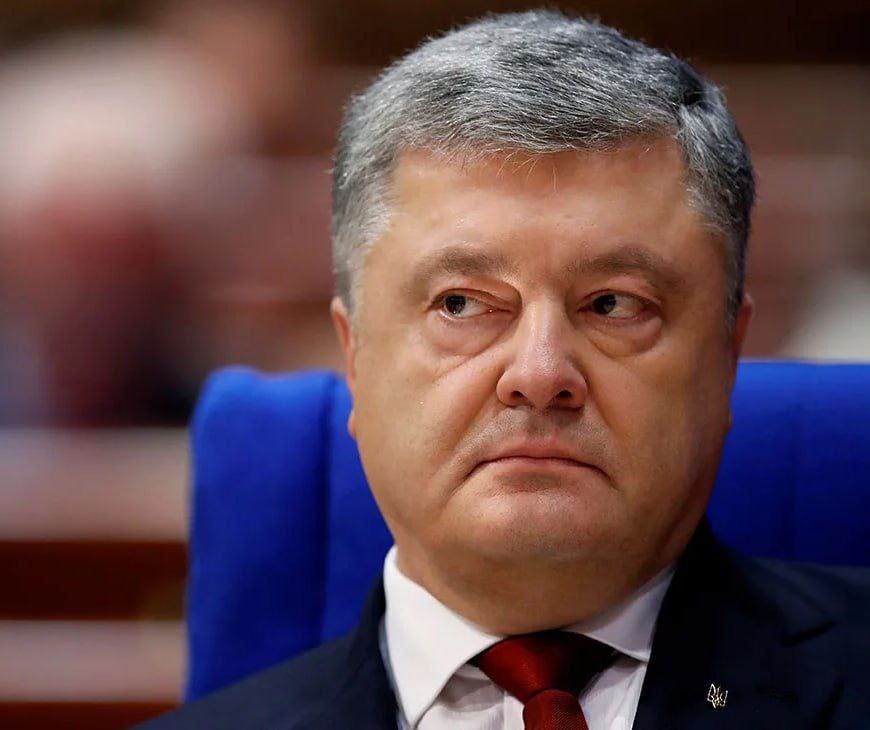
To cover up the mistakes and in order to justify their crimes, the SBU initiated a case under Article 111 of the Ukrainian Criminal Code – high treason, punishable by imprisonment from 12 to 15 years, or life imprisonment with confiscation of all property. The case was assigned to be overseen by the prosecutor Pavlo Ivanin of Prosecutor-General Office.
A problem however, the prosecution was faced with – there was no record of Yuri Ryabukha’s arrest. To solve this apparent problem, SBU officers orchestrated an elaborate staged arrest. From the concentration camp, where Colonel Ryabukha for 160 days was starved, tortured and denied medical care, the SBU operatives transported him to Sumy Oblast. On 22nd of August 2022, in collaboration with territorial defense forces they staged his “capture” on a rural road. They simply threw him out the car and detained him again.
Emaciated Ryabukha would appear in front of the court next day. Still wearing the same winter clothes he was dressed in at the concentration camp. His body over 30 kg lighter, with outgrown hair, nails and visible torture injuries. It is impossible to believe he would walk around like this on his own free will given his status.
Many legitimate questions began to arise in respect to the framework of this investigation into Colonel Ryabukha’s supposed wrongdoing. The state did not set up any surveillance, monitoring phone communications. Had they done so or requested phone records from Ryabukha’s mobile operator – it would show his last activity was on 16th of March 2022. His last pinged location would be on 33 Volodymyrska Street, Kyiv. The state was also unconcerned about Ryabukha’s whereabouts. Despite him being a senior figure at a a national military educational facility. SBU were of course unconcerned, as the knew exactly where he was. All this despite seemingly very serious accusation of high treason.
The Aftermath
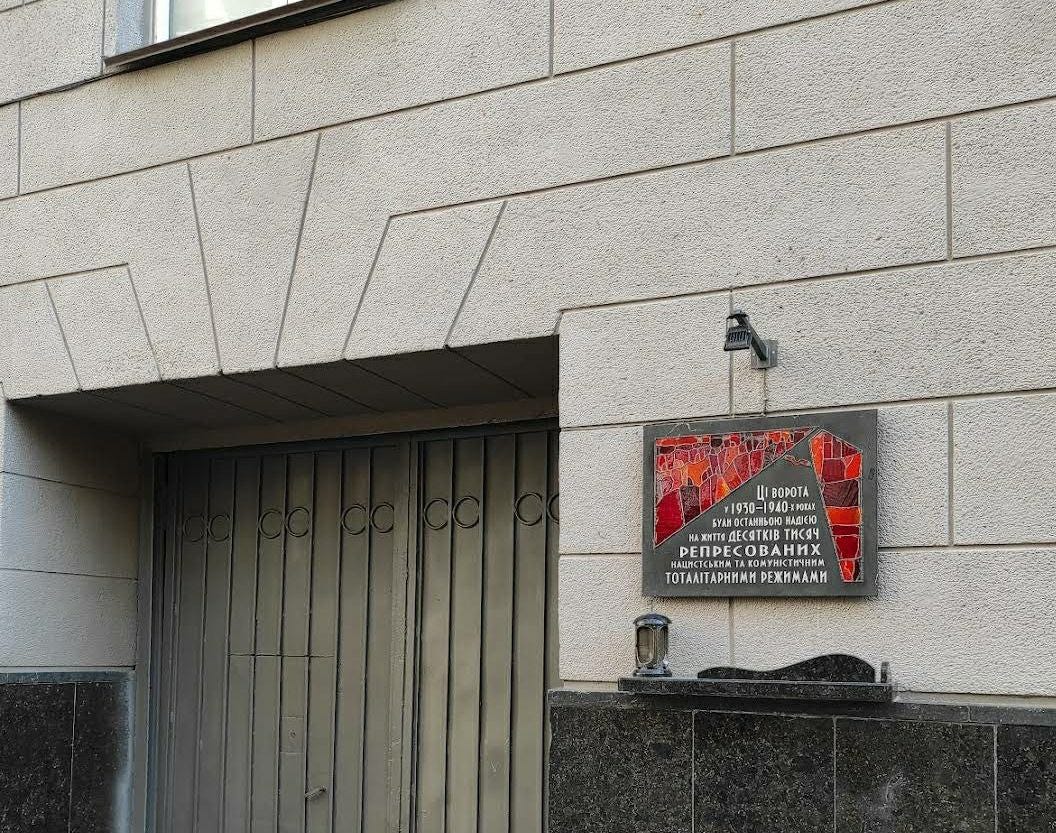
SBU’s gymnasium concentration camp broke Colonel Yuri Ryabukha’s body but not his spirit nor resolve to expose the truth.
Today, the men who orchestrated his torture—Slipchenko, Bakanov, Pinchuk and others—remain unindicted. Ryabukha had repeatedly reported atrocities committed by SBU to President Zelenskyy, Rada Chairman Stefanchuk, Defense Minister (and former Prime Minister) Shmyhal, Ombudsman Lubinets, Human Rights defender Khrystyna Kit, and to many other senior officials. His appeals would all be ignored. SBU leadership actively influenced the Shevchenkivskyi District Court of Kyiv to silence his testimony.
Key SBU figures—Ivan Bakanov and his First Deputy Vasyl Malyuk—failed to act on the disappearance of a senior SBU Colonel for five months, suggesting high-level of awareness. Prosecutors like Pavlo Ivanin and investigators such as Yevhen Voytannik dismissed victim’s statements, withheld evidence and blocked medical examinations, while the State Bureau investigator Maksym Kravchuk filed identical dismissals despite judicial rebukes.
On 17th of July 2022 [Volodymyr] Zelenskyy would remove [Ivan] Bakanov as head of the SBU, citing dozens of cases of collaboration with Russia by officials in his agency. His deputy Vasyl Malyuk would take over and still heads the SBU to this day. In the video below he explains in his own words how SBU intimidates judges to achieve prosecution of certain individuals in Ukraine.
Vasyl Hrytsak, the Head of the Security Service of Ukraine (succeeded by Ivan Bakanov), at the unveiling ceremony of the Memorial Plaque (pictured above) would say:
“The [past] owners of this building – both Stalin’s NKVD and Hitler’s SD – were united by one desire – to squeeze out the spirit of freedom from our people.”
Today, his words ring with cruel irony and Ukraine’s unresolved duality—mourning those evil historical monsters while nurturing new ones at the same time.
Gallery

